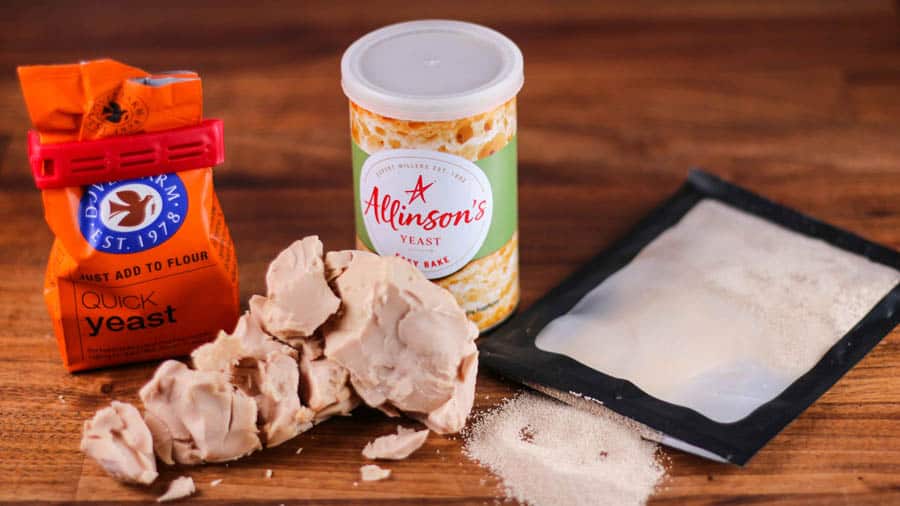The age-old question – which type of yeast should I use?
The short answer is that you should use the yeast that is available to you at the time, because there is not much difference between all the different kinds of yeast out there.
There are hundreds of yeast species in nature, but only one is used for commercial yeast production – saccharomyces cerevisiae. This strain is extremely good at gas production and it helps your bread puff up.
Commercial yeast comes in different forms from liquid, which is mostly used in large bakeries, cake yeast which we commonly call fresh yeast, and dry yeast.
So, what is the difference between the types of yeast that we find in our shops?
There are three main kinds, to narrow it down – fresh yeast, instant dry yeast, and active dry yeast.
But of course, there are others like easy bake yeast, quick yeast etc. These are basically instant dry yeast, but with a different name.
The main thing to remember is that it is all the same species of yeast, only manufactured differently. The difference is in how you use it.
Instant dry yeast and fresh yeast can be added to flour and mixed in at the same time as all other ingredients.
Active dry yeast on the other hand must be dissolved in water beforehand.
Although I would always recommend dissolving any type of yeast in water before adding flour. This will ensure that there are no lumps, and everything is well dispersed.
There is also a weight difference. Normally the required amount is calculated in relation to fresh yeast. To convert fresh yeast to instant dry yeast you must multiply it by 0.33. To convert fresh yeast to active dry yeast you must multiply it by 0.4.
So, 21g of fresh yeast equals 7g of instant yeast or 8.4g of active dry yeast.
Fresh yeast has a water content of around 70%, so you must keep that in mind when calculating your dough hydration.
But with all the formal stuff out of the way. What is the real-life-bake-at-home difference?
In my experience there is no difference. I normally use instant dry yeast because it is more convenient. It is the most readily available in the local shop, it does not go off in time unlike fresh yeast which you must keep refrigerated, and it just works.
You can use all the different kinds interchangeably. All you need to do is adjust the amount.
Is there a difference in fermentation? As I demonstrate in the video, the fresh yeast did make the dough rise a bit faster. But then you must ask yourself if that is something that you need. I must add that fresh yeast will tolerate salt and sugar a little better, so perhaps the dough rose more quickly because of that.
Is there a difference in flavour in the final loaf? Not to me. Honestly, I did not feel the slightest difference. Maybe someone would, but I think 99% of people would not.
So, why are some people so hung up on a certain kind of yeast? Why do they swear by it? Because it is the yeast that they use, and they have made great bread with it. Or perhaps someone told them to use that yeast. None of which proves that the yeast is amazing.
All you need to know is that yeast does not make bread. You make bread!
My point is that you should not worry too much about the ingredients that you use. You should spend more time learning to use them.
Great bread can be made with any yeast.
And please stay away from the blogs and grandma advice. People saying that ‘you should dissolve yeast in water with a teaspoon of sugar and wait for it to bubble up to see of it is still alive’. If you have any doubt about your yeast being alive or dead, then you should probably buy it somewhere else. You do not go to the shop every day as if it is a lottery. You certainly do not have to do that with any other ingredient, right? I hope not.
Speaking of adding sugar to yeast. Click here to see me prove that wrong too. Sugar is detrimental to yeast activity so you should never add it to yeast to ‘feed it’.
The best thing that you could do is not listen to anyone, or me for that matter, and just try for yourself. Experiment. See what works. And only then go out and tell others about your awesome methods for bread making.
Happy baking!
Watch the video down below for a side-by-side comparison.
Watch the video here



